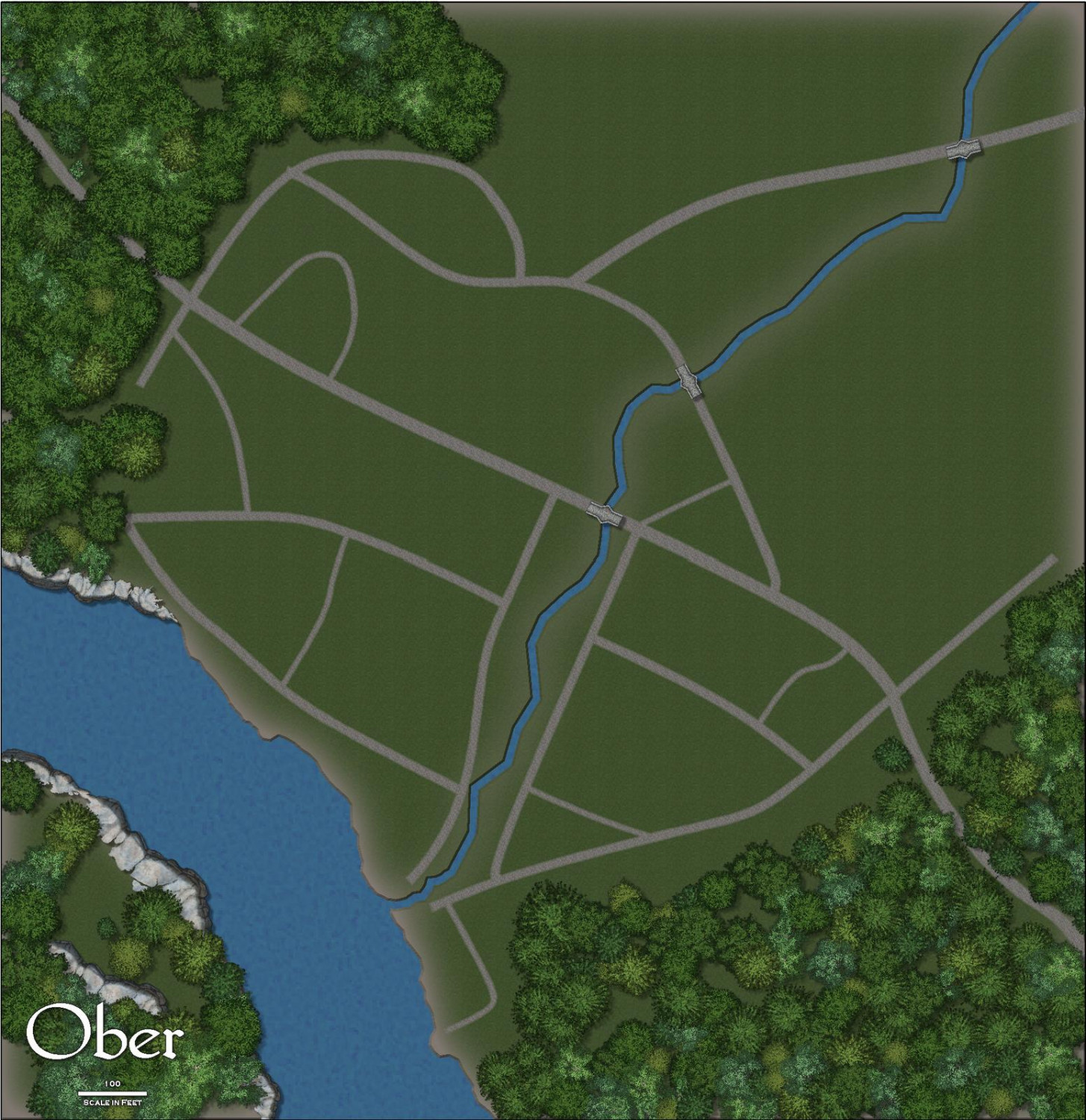1000th Map Competition: Ober, Southern Scar
 Shessar
🖼️ 34 images Mapmaker
Shessar
🖼️ 34 images Mapmaker
Just starting the layout of the terrain and village. A lot to do yet and everything is subject to change as I go. This is the first time I'm working with this annual, so I'll have to experiment and locate things from other symbol sets that I might need.






Comments
I'm starting to lay out a few details. I decided to reduce the size of the village by removing a few roads in the north. It would have been closer to town size, rather than village.
Finished laying out the areas on the west side of the stream but will add shading, walkways and paths as finishing touches. I prefer not to add too much detail until I'm sure of my layout. I've just started on the eastern side.
Next phase is complete. Last will be the river and landscape shading, labels, and the fiddly details like paths, gardens, etc.
This is really beautiful. I really like your approach with the legend on the right, having it in an entirely separate section. BTW, I noticed a little acne from the beveling down by the scale bar on the border between the map and where the legend will go. You might need to have a colored layer below the border to block that out.
Thanks @Royal Scribe ! I noticed the acne on the frame after posting. I think I'll need to make the frame a bit narrower anyway and will fix it then. I'm finding this style a real dream to work with. It is beautiful and Sue deserves many, many praises for creating it!
I love Darklands City, too. I love how much variety there is with Mike Schley's, and his style works well with some of my elven villages, but Darklands City is becoming one of my favorites. I hope ProFantasy considers having an expansion to it, or at another stand-alone city style that is complimentary so the symbols can mix and match.
Wow! Thank you!
Beautiful work, Shessar :D
I think I'm done, but want to mull it over for a few days just in case I (or you) spot something that is not quite right. :)
Very beautiful! I love the legend, too!
So pretty, I hardly like to mention anything!
But as you asked...
1 & 7 - should they both be "Oberman", or is 7 actually "Obeman"?
Also, should the fields maybe have some kind of edging - fences, hedges, or even ditches - to keep the pedestrian herbivores out, and maybe some paths leading to them too. Those to the north seem a little detached currently.
I might be inclined to name the bridges as well, though that's probably just me 😁.
Thank you!!! I missed the misspelling of Oberman, and forgot the path to the fields in the north west. I tried edging the fields, but wasn't happy with the look. I don't know why, but I really struggle with fields looking right. 🤷
For the field edgings, maybe have a look at Sue's sample map for Darklands City 2, "Brightwater", as there are variations using the hedging and wall symbols for the fields there that may help.
I know when I'm struggling with something like this, I often go back to the sample maps to see how things were done there. Doesn't always help, but it can be useful, especially if I've changed the effects settings and then want to revert to the originals, but can't recall what those were...
In Europe fields are commonly defined by hedgerows or dry stone walls. There should be tools to do that in the style if you want to put boundaries in.
Yes, perhaps the problem is that I quite often base my maps on my local area. For example, this is a google view of my best friend's farm. Not much separating the fields really. They are based more on the flat vs. hilly terrain. I'll play with the idea of hedgerows again, but I'm not certain. :)
Here is a general view of some English fields for comparison.
Yep, modern farming practices often don't equate very closely with medieval ones. Parts of the British landscape, despite such changes, still do reflect some of that in places, at least.
I am seriously curious as to the purpose of these hedges/walls. Were they merely to delineate field ownership? I know that it was mentioned to keep herbivores out, but hahahaha. As an avid vegetable gardener I know better. 🐿️🦃🦌🐇🐀
Anyway. Here's my final version, minus said hedges. 😉
Yes, one primary purpose of hedges/walls/fences is indeed to keep animals out of crop fields, and also to pen-in domesticated animals wherever they are to stop them straying. Their effectiveness is perhaps best judged by the appalling difficulties the allied armies had during the breakout from the Normandy area in the summer of 1944, following the invasion, thanks to the thick, dense hedgerows known as "bocage". Field modifications to create what were in effect bulldozer rams welded to the front of tanks had to be made just to get through the hedgelines, and even those weren't always effective.
I found this interesting article that sort of explains the existence of hedgerows in the UK. They're basically part of our culture inherited from the Bronze Age, so I guess it all depends what was going on in your part of the world 3 or 4 thousand years ago.
I guess this part of this imaginary world doesn't use hedgerows. 😊
I have a 50 foot wide swath of heavy brush and trees that is on a 40 to 50 degree grade behind my house. This is where the raccoons, groundhogs, rabbits, chipmunks, deer, turkeys and wild mice and rats live. It certainly doesn't stop them. Curse all vegetable eating varmints!
That is very interesting about hedgerows. Australia, which came to animal husbandry and agriculture rather late in the piece, uses mainly post and wire fences - often barbed wire. So I must say that is why in my villages, i tend to use simple fences rather than hedges or stone walls. Thanks, @Loopysue for you information.
If I recall correctly, the traditional hedgerow was basically a planted wall of trees, not just some unmowed patch along a stream that's overgrown by brush. In one of the strongest variants, you start with a row of trees (I forget which variety was traditional, but it had thorns) and then bend them over along the line of the row so that they will sprout all along the horizontal section and form an effectively impenetrable wall for anything much larger than a rabbit. Those vertical stems will generally be plentiful and wonderfully straight. The hedgerow does a lot of things, including property boundaries, crop defense, windbreak, ecological reservoirs for planting the things you don't want a lot of, and even helps to impound blowing snow for better water management. They do take a bit of maintenance, but they are great ways to reduce the effectiveness of calvary (mechanized or otherwise) during war.
You see a similar-looking feature pop up in rocky places with agriculture because it's hard to till rocks, so you move them to the edge of the field and stack them into walls.
The fences people build will be determined by their function and the materials available. If you really need strong fences, it's best if you can get ones that grow themselves without a lot of tending (wet green areas will tend toward hedgerows). You can build a lovely enclosure out of thornbrush that will keep various predators at bay if that's what you have, but those tend to not last particularly long. Rock fences work well and don't need a lot of tending, but tend to be extremely labor intensive and quickly get overgrown in green areas. Posts and rails (or wire for techy folks) are comparatively expensive and don't last particularly long in moist environments, but they can be an excellent choice if what you have is lots of wood and not much else. If it's cold enough that all you have is snow then you're probably not at a population density that would really require fences.
Australia is almost exclusively posts and wire. But as you said, they don't last as long as stonewalls or even hedgerows.
I'm not familiar with the fauna of the UK. Do you have groundhogs and Raccoons? They have both climbed over our 5ft high fence to destroy the celery and beans and also ripped through the 1/4 inch steel mesh cage that we had hoped would protect the carrots. I don't think a few thorns would stop them. They would simply chew and claw their way through in time, at least that's my guess.
A deer jumped the fence once then tore it up trying to get back out. It only did that once though. Now they just eat my hosta and hibiscus.
Every place has it gardening/farming challenges and ways to deal with them I suppose. Mine is to shake my fist, curse a little, then set out the traps. Varmints!
We don't have wolves, bears or wild pigs (except in areas where pigs have escaped from farms), but we do have hedgehogs, foxes, badgers, and several kinds of dear. They aren't as daylight daring as yours appear to be.
Yep, jslayton has it.
Laying-in traditional hedgerows in Britain (partly cutting and bending the stems to form an impenetrable barrier, using primarily hawthorn bushes - very spiky - also called "May", because of when it blossoms, and the spring greening hedgerows turn white with flowers) is an art still practiced in the UK, albeit by many fewer folk than was once the case, although it has become more popular in recent years again. Other trees might be planted along with them in places, although a lot of trees are seeded by birds, and sometimes squirrels, along with a great variety of wild plants more generally (because the thorny hedgerows make great, safe places to build a nest and take shelter).
Aside from occasional feral pigs in the UK, we do have a few reintroduced wild boar in places, and some very recently reintroduced beavers as well, along with some escapee capybaras, again in only a few spots. Deer can be a real problem in some areas, as they have no natural predators here, with far fewer hunted for "sport" than was once the case, and do cause problems for farmers at times. No groundhogs or raccoons, at least!
Fascinating info. I love the forums here because we learn about the world as well as making maps of it. Thanks everyone!
Even if we did hijack your topic completely 😉😁!